Editor’s Note
Yellow River, China’s second-longest river, flows along the country’s north border in some of its upper and middle reaches where several large deserts locate. From time to time, tons of sand has been carried by the wind from the deserts and poured into the river. The increased sediment concentration will elevate the river bed and aggravate floods, casting a severe threat to lives and properties along the banks. China now sees protecting Yellow River vital for its national rejuvenation as well as sustainable development, and a thorough understanding of the sand transportation mechanism plays a key role in river regulation and management.
Engaged in relevant research is the Grassland Soil Protection and Ecological Restoration team of the Department of Water Resources for Pastoral Area of IWHR. Dr. GUO Jianying, leader of the team, was awarded “Young Innovative Talent of Grassland” by Inner Mongolia province as well as “Outstanding Young Talent” by IWHR. Today’s IWHR innovation story brings you closer to such a team of young scientists, who has spent more than eight years in deserts as they greatly pushed forward the ecological conservation and high-quality development of the Yellow River Basin.
Starting a water conservation career as the motherland needed
In 2011, Dr. GUO Jianying graduated from Beijing Forestry University and started his career at the Department of Water Resources for Pastoral Area of IWHR, concentrating on soil and water conservation.
It was not long after he entered IWHR that the construction of Heisanxia (also known as Daliushu) Reservoir in the upper Yellow River area took place. When it comes to how the ecological environment changes along the Yellow River and how the wind-drifted sand is exactly transported, there wasn’t systematic study nor sufficient long-sequence first-hand data at that time. There was only an estimated volume of sand transported into Yellow River from Ulanbul desert ranging widely from 160,000 to 120 million tons. There was a huge disparity in opinions on the mechanism of the transporting process, making it hard to decide the plans and methods for river harnessing.
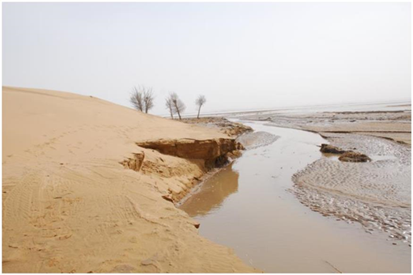
Flowing sand hills enter the Yellow River directly
To precisely estimate the amount of sand transported, Dr. GUO Jianying led the Grassland Soil Protection and Ecological Restoration team to the uninhabited Liuguaizi sand front, a place in the eastern Ulanbul desert where the desert and Yellow River intersect, to study the wind-drifted sand. The team consists of Dr. GUO, four other experts and five graduate students, averaging no more than 39 in age.
The team spent more than one-third of their time working in the field during the eight years. In face of the harsh working conditions with strong wind blowing and hot sun burning, Dr. GUO always encouraged the team members to rise up to the challenges and stay true to their original aspiration that is the great future of the pastoral area.
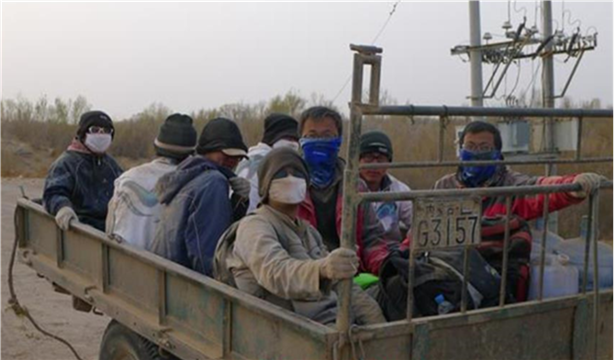
Sand-covered team members on their way for observation
Overcoming difficulties to push the boundary
The team conducted their investigation in the famous Lop Nur as well as several big deserts in north-western China. Starting from the very beginning of the year when most people were still celebrating the Spring Festival with their families, these young scientists had already embarked on a new journey of field observation and experiments. Sometimes they need to walk under the burning sun in the desert with a temperature of above 40 Celsius degree for a whole day with only some bread, buns and Nang – a traditional Xinjiang pancake –for food.
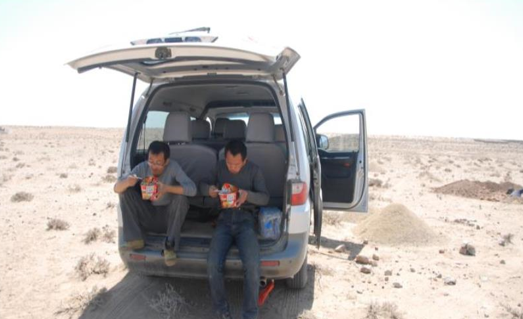
Team members had their quick lunch during investigation
The travel way to the investigation field was far from being convenient either. The test site in the desert was 20 kilometers (about 12.5 miles) away from the nearest town. Cars and trucks often got stuck in the sand, thus team members usually needed to carry the experimental equipment by hand into the desert. Once it took them six hours to go back and forth five times to carry all equipment to the test site by hand over a distance of three kilometers (about 1.7 miles).
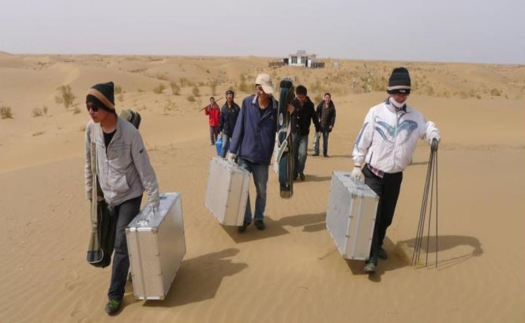
Team members walking to test field carrying the equipment
The wind speed changes rapidly and irregularly in deserts, adding to difficulties of the observation of wind strength and vertical distribution of wind-drifted sand near ground surface.
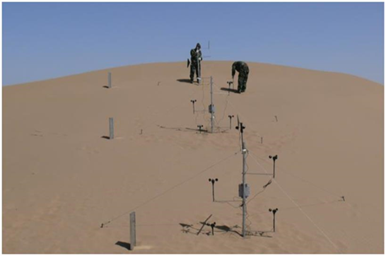
Observing the structure of wind-drifted sand flow
In order to obtain an abundant amount of detailed data that are statistically significant, referring to local weather forecast, the team members always stuck to the observation point with their recorder and sand sampler, regardless of extreme summer heat, winter cold, or the strong wind in spring.
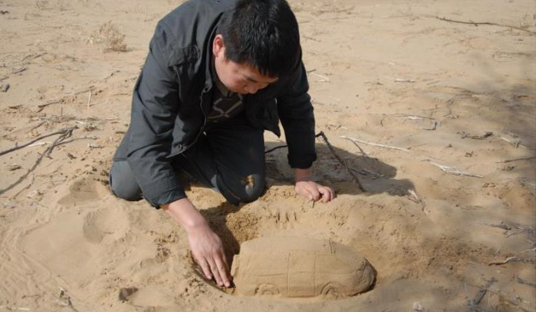
One team member played with the sand to seek some joy in the harsh condition
The Inner Mongolia section of the Yellow River is at the northernmost part of the riverbasin, where the winter is extremely freezing and the lowest temperature along the river banks can be -35.3 Celsius degree. However, the young scientists have never been afraid of working on the frozen river in the biting wind.
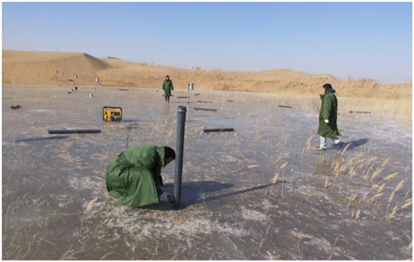
Sampling the transported sand on ice surface in the winter
To obtain data of the wind, they had to sometimes wait in the desert till late at night. One team member said that the desert made him feel nostalgic. Looking at the moon, he would thought about his parents who were concerned about him, and his little child who asked “When would daddy come back?” when he left. But he still stuck to his position to wait for the wind. The wind would bring sand, and the sand would bring the data they needed. The more data collected, the closer the day was to go home.
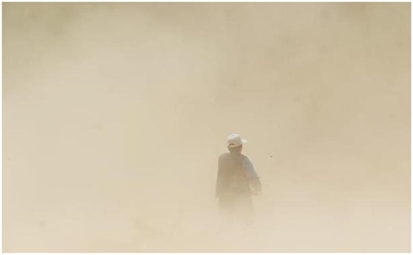
Sampling in the sandstorm
Fruitful outcomes of eight years’ hard work
Hard work always pays off. With concrete support from China’s National Natural Science Foundation, the Special Research Project for Public Welfare of the Ministry of Water Resources of China, the Special Research Project of IWHR, etc., the team obtained more than 600,000 pieces of fundamental first-hand data during the eight years. Their research preliminarily revealed the structure of wind-drifted sand flow, shape and movement of sand hills, situation of land use, etc., along the Ulanbuh desert section of the Yellow River, providing a solid basis for precise estimation of the volume of wind-drifted sand that enters the Yellow River.
The research results were published on Geomorphology, Transactions of the Chinese Society of Agricultural Engineering, Journal of Desert Research and other domestic and international journals, significantly fueling blown sand physics research on the movement of wind-drifted sand on different underlying surfaces.
In recent years, China has been attaching greater and greater importance to protecting the environment in pastoral areas. Dr. GUO Jianying and the team devoted themselves to the investigation of vegetation, soil, water resources, drinking water for people and livestock, and life of pastoral residents on grasslands in each middle of July since 2017, to gain a comprehensive understanding of the current ecology and environment status of the wild pastoral areas nationwide. In the two years, travelling far as more than 600 kilometers (373 miles) per day and 50,000 kilometers (310,685 miles) in total, the team left their footprints on vast grasslands in eight provinces and autonomous regions.
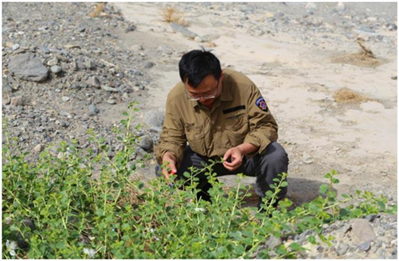
Investigating local vegetation in Kashgar, Xinjiang
Through tremendous field investigations, the team basically drew up a map of the distribution of vegetation and crops in desert regions as well as their value, significantly facilitating the protection and improvement of the fragile desert environment.
The journey of these dream chasers never stop. Next, the team will head for the world’s highest Qinghai-Tibet Plateau for deep research on composition, structure, function and usage of plateau vegetation as well as the influence from human activities. Sticking to their commitment to the motherland, these young scientists are ready to dedicate their youth to the country’s prosperity and people’s happiness.








